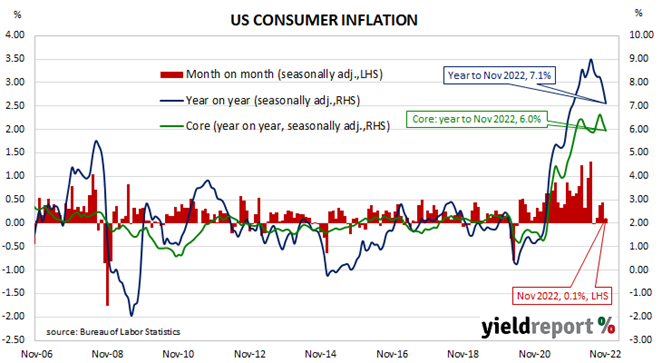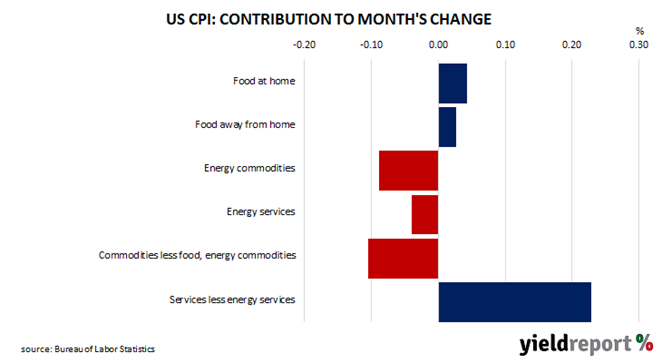Summary: US CPI up 0.1% in November, less than expected; “core” rate up 0.2%; inflation pressures easing; Treasury yields fall significantly; rate-rise expectations soften considerably; softening goods inflation, persistent services inflation theme “intact”; non-energy services again main driver, adds 0.23 ppts.
The annual rate of US inflation as measured by changes in the consumer price index (CPI) halved from nearly 3% in the period from July 2018 to February 2019. It then fluctuated in a range from 1.5% to 2.0% through 2019 before rising above 2.0% in the final months of that year. Substantially lower rates were reported from March 2020 to May 2020 and they remained below 2% until March 2021. Rates have since risen significantly.
The latest CPI figures released by the Bureau of Labor Statistics indicated seasonally-adjusted consumer prices increased by 0.1% on average in November. The result was noticeably below the generally expected figure of 0.3% as well as October’s 0.4% increase. On a 12-month basis, the inflation rate slowed from 7.8% to 7.1%.
“Headline” inflation is known to be volatile and so references are often made to “core” inflation for analytical purposes. The core prices index, the index which excludes the more variable food and energy components, increased by 0.2% on a seasonally-adjusted basis for the month. The rise was less than the expected increase of 0.3% as well as the 0.3% increase which took place in October and the annual growth rate slowed from 6.3% to 6.0%.
“So, although prices are still rising, they are rising at the slowest rate in over a year, indicating inflation pressures are easing,” ANZ Head of FX Research Mahjabeen Zaman.
US Treasury bond yields finished significantly lower on the day. By the close of business, the 2-year Treasury yield had shed 18bps to 4.21%, the 10-year yield had lost 10bps to 3.51% while the 30-year yield finished 4bps lower at 3.53%.
In terms of US Fed policy, expectations of higher federal funds rates over the next 12 months softened considerably. At the close of business, contracts implied the effective federal funds rate would average 4.11% in December, 28bps higher than the current spot rate, and then climb to an average of 4.65% in February. May futures contracts implied a 4.845% average effective federal funds rate while November contracts implied 4.545%.
“Energy was a bit drag on [the] headline but, even so, the ex-food and energy core print of 0.2% was 0.1 percentage points lower than expected,” said NAB senior interest rate strategist Ken Crompton. “The broad theme of rapidly softening goods inflation and more persistent services inflation definitely remains intact.”
The largest influence on headline results is often the change in fuel prices. Prices of “Energy commodities”, the segment which contains vehicle fuels, decreased by 2.0% and subtracted 0.09 percentage points. However, prices of non-energy services, the segment which includes actual and implied rents, again had the largest effect on the total, adding 0.23 percentage points after increasing by 0.4% on average.



